
The Mahābhārata is one of the two major Smriti texts and Sanskrit epics of ancient India revered in Hinduism, the other being the Rāmāyaṇa. It narrates the events and aftermath of the Kurukshetra War, a war of succession between two groups of princely cousins, the Kauravas and the Pāṇḍavas.

Sanjaya or Sanjaya Gavalgana is a figure from the ancient Indian Hindu epic Mahābhārata. Sanjaya is the advisor of the blind king Dhritarashtra, the ruler of the Kuru kingdom and the father of the Kauravas, as well as serving as his charioteer. Sanjaya is a disciple of Sage Vyasa. He is stated to have the gift of divya drishti, the ability to observe distant events within his mind, granted by Vyasa. He narrates to Dhritarashtra the events of the Kurukshetra War, including the ones described in the Bhagavad Gita.

Kurukshetra is a city and administrative headquarters of Kurukshetra district in the Indian state of Haryana. It is also known as Dharmakshetra and as the "Land of the Bhagavad Gita".

The Kurukshetra War, also called the Mahabharata War, is a war described in the Hindu epic poem Mahabharata , arising from a dynastic struggle between two groups of cousins, the Kauravas and the Pandavas, for the throne of Hastinapura. The war laid the foundation for the events of the Bhagavad Gita.
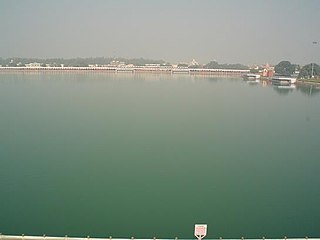
Brahma Sarovar is an ancient water pool and largest sarovar, sacred to Hinduism in old Kurukshetra city, in the state of Haryana in North India. Hinduism lays emphasis on taking bath for internal and external purity. Most religious sites have water pools or sarovar in or near the Hindu temple and Sikh gurdwara. The Hindu genealogy registers at Kurukshetra, Haryana are kept here.

Kurukshetra district is one of the 22 districts of Haryana state in northern India. The town of Kurukshetra, a sacred place for the Hindus, is the administrative headquarters of this district. The district occupies an area of 1530.00 km². The district has a population of 964,655. This district is part of Ambala division. Kurukshetra is also the land of Srimad Bhagawad Gita. Jyotisar is the place in Kurukshetra where Krishna is believed to deliver the sermon of Gita to Arjuna in the Mahabharata.

Gita Mahotsav,Gita Jayanti, also known as Mokshada Ekadashi or Matsya Dvadashi is a Hindu observance that marks the day the Bhagavad Gita dialogue occurred between Arjuna and Krishna on the battlefield of Kurukshetra. It is celebrated on Shukla Ekadashi, the 11th day of the waxing moon of the lunar month Margashirsha (December–January) of the Hindu calendar.
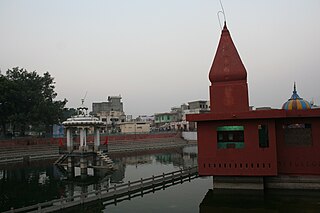
Pehowa (old name Pitrudhak Teerth) is a town and a municipal committee in Kurukshetra district in the Indian state of Haryana. It is an important sacred Hindu pilgrimage site, related to Krishna and Mahabharata, within the 48 Kos Parikrama of Kurukshetra. The Hindu genealogy registers at Peohwa, Haryana are kept here at the Pruthudak Tirath on the banks of Sarasvati river.
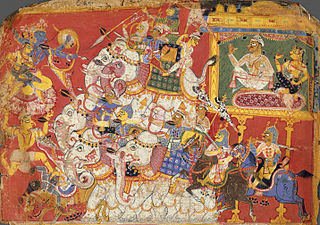
Bhagadatta was the son of Narakasura, and the king of Pragjyotisha in Hindu mythology. Bhagadatta was born from a limb of the asura called Bashkala. He was a renowned warrior, and was known to be a great friend of Indra. When Arjuna embarked on a conquest to help his brother Yudhishthira perform the rajasuya yajna, Bhagadatta was one of the first kings to be conquered by him.

Bilaspur is a census town and block headquarter in Yamunanagar District in the state of Haryana, India. It takes its name from the corrupted form of "Vyas Puri", as it was the ashram of Ved Vyasa rishi where he wrote the Mahabharta on the banks of Sarasvati river near Adi Badri where Sarasvati river leaves Himalayas and enters the plains. On Jagadhari road lies another popular religious site of Kapal Mochan.

Yātrā, in Indian-origin religions, Hinduism, Buddhism, Jainism and Sikhism, generally means a pilgrimage to holy places such as confluences of sacred rivers, sacred mountains, places associated with Hindu epics such as the Mahabharata and Ramayana, and other sacred pilgrimage sites. Visiting a sacred place is believed by the pilgrim to purify the self and bring one closer to the divine. The journey itself is as important as the destination, and the hardships of travel serve as an act of devotion in themselves.
Abhimanyupur is a village in Kurukshetra district of Haryana, India. This village is 8 kilometres from the city of Kurukshetra. This village is famous for being the site where Abhimanyu, the son of Arjuna, died in the Mahabharata War. This is the site where the Kauravas arranged the deadly "chakravyuha" formation and trapped and killed Abhimanyu. This village is part of the 48 kos parikrama of Kurukshetra. This village has many sacred places associated with Hinduism.

The Bhagavad Gita, often referred to as the Gita, is a 700-verse Hindu scripture, which is part of the epic Mahabharata. It forms the chapters 23–40 of book 6 of the Mahabharata called the Bhishma Parva. The work is dated to the second half of the first millennium BCE.
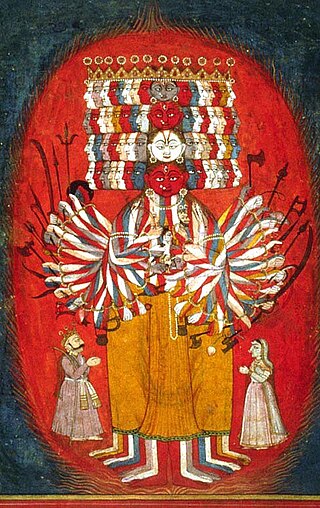
Bhagavad Gita is a 1993 Indian Sanskrit-language drama film with few dialogues in Hindi and Telugu language. It was produced by T. Subbarami Reddy and directed by G. V. Iyer. The film is based on Hindu religious book Bhagavad Gita, which is part of the epic Mahabharata.

Vishvarupa, also spelt as Vishwaroopa and known as Virata rupa, is an iconographical form and theophany of a Hindu deity, most commonly associated with Vishnu in contemporary Hinduism. Though there are multiple Vishvarupa theophanies, the most celebrated is in the Bhagavad Gita, given by Krishna in the epic Mahabharata, which was told to Pandava prince Arjuna on the battlefield of Kurukshetra in the war between the Pandavas and Kauravas. Vishvarupa is considered the supreme form of Vishnu, where the whole universe is described as contained within him.

The Mini Zoo is located on Grand Trunk Road near Pipli bus stand in Kurukshetra, Haryana, India.
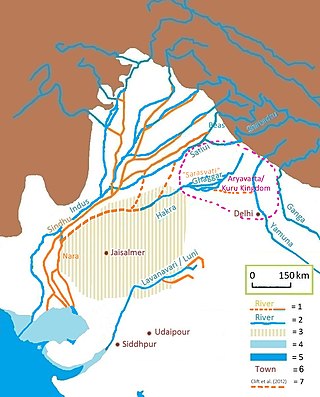
The Sarsuti river, originating in Sivalik Hills and flowing through the palaeochannel of Yamuna, is a tributary of Ghaggar river in of Haryana state of India. Its course is dotted with archaeological and religious sites dating back to post-Harrapan Mahabharata sites from Vedic period, such as Kapal Mochan, Kurukshetra, Thanesar, Brahma Sarovar, Jyotisar, Bhor Saidan and Pehowa.
Adi Badri, also Sri Sarasvati Udgam Tirath, is a tourist site of archaeological, religious and ecological significance in a forest area in the foothills of the Sivalik Hills in Bhabar area, situated in northern part of Yamunanagar district, of the north Indian state of Haryana. There are remains of many Buddhist stupas and monasteries, which are about 1500–2000 years old, and there is also a group of Hindu temples from the 9th century. Based on the multiple archaeological excavations undertaken here, archaeologists have sent the proposal to Archaeological Survey of India (ASI) to include this site in the list of protected heritage site. Several popular annual festivals are held here, including the five day long National Saraswati Festival in January, Adi Badri Akha Teej Mela in Vaisakh around April–May, week-long Adi Badri-Kapal Mochan Kartik Purnima religious mela around November.

The 48 kos parikrama is a parikrama of various Mahabharata-related and other Vedic-era tirthas around the holy city of Kurukshetra in the state of Haryana, India.

The Arjuna Vishada-yoga is the first of the eighteen chapters of the Bhagavad Gita. The chapter has a total of 47 shlokas. The chapter is the 23rd chapter of Bhishma Parva, the sixth book of the Mahabharata.
























